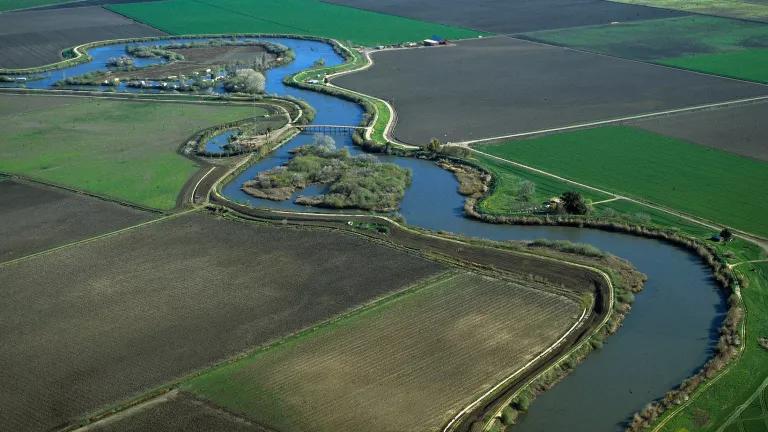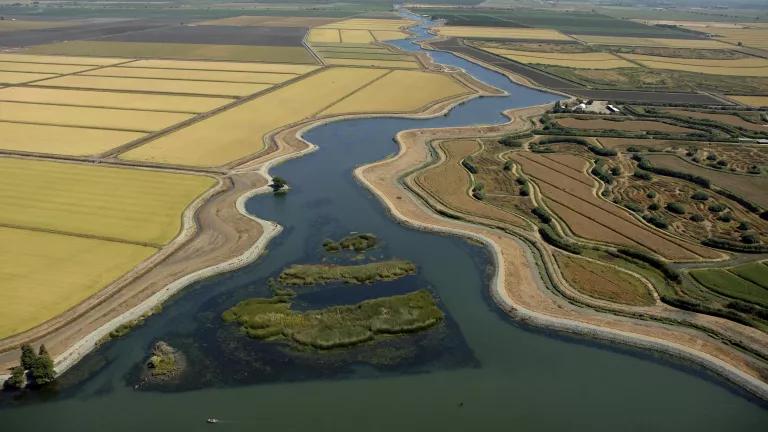CA's Natural Resources Agency Can't Debunk the Portfolio Approach to Resolving Threats to the Delta
Last week our Natural Resources Agency, the umbrella agency responsible for protecting California’s coast, ocean, wildlife and forests and for managing our water, released a deeply flawed justification for rejecting a portfolio approach that dozens of water agencies, local governments and environmental groups support for planning the future of California’s water supply. Outlined below are just a few of the reasons why the Agency’s refusal to consider alternatives to the big tunnel plan doesn’t hold water.
We don’t understand why Resources would reject a portfolio approach at this point in the environmental analysis. Even worse, to base its rejection on misinformation and flawed analyses makes no sense. We agree wholeheartedly with Secretary Laird when he notes in his cover letter that “California stands at a precipice [regarding] decisions in the California Delta….” Whether the State launches headlong over that precipice or pulls itself back from the edge by implementing a balanced portfolio of sound water management practices depends on the decisions made by Governor Brown and his responsible State officials over the next few months. NRDC stands ready to assist the State in moving California to a sustainable water future. Viable solutions have been presented, including the portfolio alternative. The public wants a mix of water supply sources. We need leadership that will listen to the public and make the tough calls.
(1) Resources says: “the fundamental premise that cost savings from building a smaller facility could generate funding for substantial and adequate investments in other regional and local water supply to meet California’s future water needs does not bear out.”
WHY THIS ARGUMENT IS FLAWED: On page 3 of their very own analysis, the Resources Agency states that a single-tunnel, 3,000 cfs tunnel costs $6 billion less than the currently-proposed dual-tunnel, 9,000 cfs twin tunnels - $8.5 billion as compared to $14.5 billion. NRDC recently analyzed the amount of new water supply that could be generated from $5 billion of investment in water recycling and urban water conservation. Those investments yielded between 926,000 and 1,240,000 acre-feet of permanent new water annually. That’s a lot of new water that could be created in areas that are now more dependent on water exports from the Delta than they want to be. Developing water locally implements the State’s policy to reduce reliance on the Delta. If you add this new water supply to the 4.2 MAF average supply from the Delta that the State says a smaller, less expensive tunnel would yield, the portfolio approach provides more water and a more reliable water supply at less cost than provided by the current BDCP two big tunnels approach:
| Conveyance size | 9,000 cfs, two-tunnel facility | 3,000 cfs, single-tunnel facility |
| Estimated cost |
$14.5 billion
(capital cost of tunnels) |
$13.5 billion
($8.5 billion capital cost of tunnel + $5 billion in sustainable local supplies) |
| Water supply | 4.7 MAF/year |
5.1 – 6.4 MAF/year
(4.2 MAF/year from Delta + 900-1.2 TAF from new local supplies) |
This approach not only bears out, it makes far more sense than the current BDCP proposal, even if you assume that the State can manage to get permits from federal and state wildlife protection agencies for a facility yielding 4.7 MAF, a proposition which is not scientifically justified.
(2) Resources claims that “the 3,000-cfs tunnel has a negative benefit cost ratio, largely because the cost of the 3,000-cfs tunnel is approximately two thirds of building the proposed 9,000-cfs twin tunnels but the water yield is much smaller.”
WHY THIS ARGUMENT IS FLAWED: It is based on at least two fundamental fallacies:
- First, the analysis ignores the increased water yield associated with investing the savings from a smaller facility in local water resources development. When that yield is added in, a portfolio approach yields more water than the currently proposed BDCP project, as shown above.
- Second, Resources relies on the cost-benefit analysis presented in BDCP draft Chapter 9, but Chapter 9 overestimates the cost of a 3,000-cfs tunnel by more than $2 billion according to the State’s new analysis. Resources 9/11/13 analysis states that a single-bore, 3,000 cfs tunnel costs $8.5 billion. But the BDCP cost-benefit analysis pegs the cost of a 3,000 cfs facility at $10.8 billion. See Table 9.B-6.
Resources’ assertion that the costs of a smaller facility outweigh the benefits is based on overestimating costs by at least $2 billion and underestimating water supply yield by about 1 million acre-feet, rendering it inapplicable to the portfolio alternative.
(3) Resources debunks the value of investing $5 billion in local and regional water supplies, claiming that “it is doubtful that a $3 billion investment [in sustainable local water supplies, like water recycling and conservation] would produce even 100,000 acre-feet of reliable new water supply in urban areas.” See page 5 of 9/11/13 analysis.
WHY THIS ARGUMENT IS FLAWED: This statement is contrary to the actual experience and combined expertise of numerous water districts that have implemented and proposed innumerable recycling and conservation projects around the State. Indeed, it is contrary to DWR’s own analyses in recent water plan updates, which conclude that:
“An estimated 1.4 million to 1.7 million acre-feet of additional wastewater could be recycled in California by the year 2030, of which 0.9 million to 1.4 million acre-feet (62 to 82 percent) would be recycled from discharges that would otherwise be lost to the ocean, saline bays, or brackish bodies of water (RWTF, 2003). The potential capital cost to implement that level of water recycling is estimated to be about $9 billion to $11 billion (ibid.). Given the variability of local conditions and their effect on treatment and distribution costs, the estimated range of capital and operational costs of water recycling range from $300 to $1,300 per acre-foot of recycled water, but in some instances costs above of this range are encountered.” Page 11-10 of 2009 Water Plan Update.
With regard to urban efficiency measures, DWR cites CALFED analyses to conclude that “the average cost of urban conservation measures would be between $150 and $450 per acre-foot (CALFED, 2000). CALFED’s analysis of urban conservation potential suggests somewhat higher average costs, ranging, when rounded, between $220 and $530 per acre-foot. Both estimates indicate that investment in urban conservation can be a very cost-effective strategy for addressing growing urban demand for water.” Page 3-26 of California Water Plan Update.
Using DWR’s estimates, a $3 billion investment in water recycling would produce around 400,000 acre-feet in reliable new water supplies, and a $3 billion investment in urban efficiency could produce several million acre-feet of new supplies. That’s a far cry from the less than 100,000 acre-feet that Resources’ 9/11/13 analysis claims. This NRDC analysis provides more information about the cost and yield of several additional recent analyses, all of which produce far greater water supply at less cost than the State’s 9/11/13 estimate.
(4) Resources claims that the portfolio alternative “may undermine” achieving biological objectives by pumping more from the existing south Delta pumps and reducing the amount of tidal marsh habitat restored by one-third.
WHY THIS ARGUMENT IS FLAWED:
- The portfolio alternative proposes operating the new and existing pumps according to a set of operations developed by the fish and wildlife agency biologists to reflect the best available science. These operations are more protective than those in the current BDCP proposed project, resulting in better flows for fish and wildlife and lower exports from the Delta. Reducing exports and increasing flows is one of the most important actions we can take to help restore the health of the Delta, as the PPIC’s survey of scientists found. Resources did not use these operations in looking at the impacts of the portfolio alternative. Instead, it relied on BDCP’s own analysis in Chapter 9 that diverts far more water from the south Delta pumps than the portfolio alternative would. That makes it meaningless to judge the impact of the portfolio alternative on fish.
- Even with a large new pumping facility, the current BDCP proposal continues to rely on the existing pumps in the South Delta for more than 50 percent of all water exports, including more than 2/3rds of all exports in drier years. And the National Marine Fisheries Service has warned that significant water diversions from a new facility on the Sacramento River could substantially reduce salmon survival through the Delta, rather than improving survival. Unfortunately, there appears to be very little environmental benefit from the current BDCP proposal for most fish species of concern, with many endangered species continuing to decline and some salmon runs even going extinct.
- BDCP claims that the portfolio alternative reduces from 65,000 acres to 40,000 acres that amount of tidal marsh habitat that would be restored. But there is very little scientific support for a conclusion that restoring tidal marsh habitat will benefit imperiled fisheries, and these projects may, in fact, worsen estuarine conditions by bolstering invasive species if not done carefully. The portfolio alternative suggests expediting some habitat restoration in the near term and then studying the effects before doing more, so that we’re reducing uncertainty and investing wisely.
The science is overwhelming that we must move away from the current approach of diverting more than half of the freshwater flowing into the Delta on average to improve the biological health of the estuary. That means we need to take significantly less water from the Delta than today in order to restore salmon and other imperiled species, not more, as proposed by the current BDCP plan.
(5) Resources claims that “there is a high likelihood of a major earthquake that will collapse from several to many Delta islands” that water exports could be curtailed for up to 10 years, and that a 3,000 cfs facility would be insufficient to “avert huge economic losses.”
WHY THIS ARGUMENT IS FLAWED:
- The portfolio alternative proposes to invest $1 billion of the cost savings from a smaller, less expensive tunnel into improving Delta levees to protect not only water exports, but the millions of people, homes, and businesses in the Delta who could suffer the devastating impacts of a catastrophic Delta collapse even if two large tunnels were built. (The Delta Stewardship Council has found that more than 80 percent of the economic losses from a massive levee failure would be in the Delta, with less than 20 percent due to water supply impacts.) And massive levee failures causing multiple islands to flood likely would create hotspots for predators and invasive species, resulting in significant environmental impacts as well. BDCP’s current proposal doesn’t address these risks to life, property, and the environment.
- Resources claims regarding the economic impacts of a catastrophic outage are contradicted by BDCP’s cost-benefit analysis, which found that the economic benefits of reduced seismic risk from the State’s 9,000 cfs proposal is only $470 million – compared to a total cost of over $13 billion. It also ignores the Army Corps of Engineers’ formal comment that, “A through delta surface conveyance may not pose more seismic risk than subsurface conveyance.” Page 8 of USACE July 2013 comments on draft BDCP.
- In contrast to Resources’ suggestion that water exports from the Delta would be curtailed for a decade, the PPIC has noted that, “Over the past few years, the Department of Water Resources and water exporters have been developing emergency responses to reduce the worst-case outage to no more than six months.”
Seismic risks facing the Delta demand greater investment in flood protection to protect all the resources of the Delta, and greater investment in local water supplies to reduce reliance on the Delta in the event of a disruption in Delta exports. While additional conveyance facilities may also be appropriate to help address this risk, the State’s own cost-benefit analysis does not justify investing in large, twin tunnels on the basis of alleviating earthquake risks.



